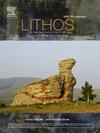New integrations of UPb zircon data from Caledonian intrusions in the Southern Uplands of Scotland
IF 2.9
2区 地球科学
Q2 GEOCHEMISTRY & GEOPHYSICS
引用次数: 0
Abstract
The Laurentian margin in Britain and Ireland experienced the Caledonian-Acadian orogenies resulting from Palaeozoic closure of the Iapetus Ocean and accretion of Baltica and peri-Gondwanan terranes. However, the age and significance of magmatism remain contested, without a geologically consistent geodynamic reconstruction. We have interrogated the U![]() Pb zircon record of intrusive complexes within the Southern Uplands-Down-Longford accretionary complex, focused on the Southern Uplands in Scotland. New texturally constrained laser ablation data are presented from the Carsphairn, Black Stockarton Moor, Bengairn, and Cheviot complexes. In these locations, most zircons contain poorly zoned cores with 206Pb/238U ages no older than ∼ 424 Ma, chemically comparable with younger magmatic overgrowths. Magmatic overgrowth ages confirm emplacement of Carsphairn at ∼ 414–411 Ma, Black Stockarton Moor and Bengairn at ∼ 410–408 Ma, and Cheviot at ∼ 400 Ma. Across the accretionary complex, the onset of zircon growth from ∼ 424 Ma appears to mark slab roll-back processes. Zircon cores may represent stalling and crystallisation of magmas in the deep crust, whilst emplacement into the shallow crust after ∼ 415 Ma accompanies the onset of regional transtension. We do not feel there is sufficient evidence to directly attribute magmatism to slab breakoff, despite this process being popularly championed in Scottish and Irish geology. We discuss the latest geodynamic interpretations of magmatism during the Caledonian-Acadian events, including events to the south of the Iapetus suture, and argue that complete zircon histories have a role to play in reconstruction of ancient orogens.
Pb zircon record of intrusive complexes within the Southern Uplands-Down-Longford accretionary complex, focused on the Southern Uplands in Scotland. New texturally constrained laser ablation data are presented from the Carsphairn, Black Stockarton Moor, Bengairn, and Cheviot complexes. In these locations, most zircons contain poorly zoned cores with 206Pb/238U ages no older than ∼ 424 Ma, chemically comparable with younger magmatic overgrowths. Magmatic overgrowth ages confirm emplacement of Carsphairn at ∼ 414–411 Ma, Black Stockarton Moor and Bengairn at ∼ 410–408 Ma, and Cheviot at ∼ 400 Ma. Across the accretionary complex, the onset of zircon growth from ∼ 424 Ma appears to mark slab roll-back processes. Zircon cores may represent stalling and crystallisation of magmas in the deep crust, whilst emplacement into the shallow crust after ∼ 415 Ma accompanies the onset of regional transtension. We do not feel there is sufficient evidence to directly attribute magmatism to slab breakoff, despite this process being popularly championed in Scottish and Irish geology. We discuss the latest geodynamic interpretations of magmatism during the Caledonian-Acadian events, including events to the south of the Iapetus suture, and argue that complete zircon histories have a role to play in reconstruction of ancient orogens.
求助全文
约1分钟内获得全文
求助全文
来源期刊

Lithos
地学-地球化学与地球物理
CiteScore
6.80
自引率
11.40%
发文量
286
审稿时长
3.5 months
期刊介绍:
Lithos publishes original research papers on the petrology, geochemistry and petrogenesis of igneous and metamorphic rocks. Papers on mineralogy/mineral physics related to petrology and petrogenetic problems are also welcomed.
 求助内容:
求助内容: 应助结果提醒方式:
应助结果提醒方式:


